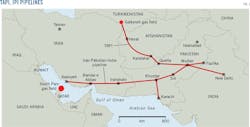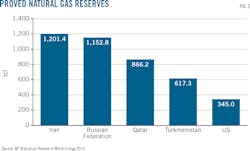Manish Vaid
Observer Research Foundation
New Delhi
Sanjay Kar
Rajiv Gandhi Institute of Petroleum Technology
Uttar Pradesh, India
The Turkmenistan-Afghanistan-Pakistan-India (TAPI) pipeline has progressed, but its future remains uncertain. Four major events have marked TAPI's progress. First among these was its steering committee's unanimous endorsement of Turkmengaz as consortium leader of TAPI Pipeline Co. Ltd., in charge of building, financing, owning, and operating the pipeline, during the committee's 22nd meeting, in Ashgabat, Turkmenistan (OGJ Online, Aug. 6, 2015). Shares in TAPI Pipeline Co. Ltd. are equally owned by Turkmengaz, Afghan Gas Enterprise, Inter State Gas Systems (Private) Ltd., and GAIL (India) Ltd.
The second development came Oct. 24, 2015, when Turkmenistan, Afghanistan, Pakistan, and India initialed1 TAPI's shareholding agreement, which set forth principles regarding the pipeline's management and operation, the rights and obligations of shareholders, and the ownership and transfer of shares. Groundbreaking of TAPI's Turkmen portion followed on Dec. 13, 2015. Earlier this year, the four parties signed an investment agreement,2 paving the way for updating TAPI's feasibility study and finalizing its route through Afghanistan.
This article discusses problems which could affect TAPI's successfully starting operations in 2019 despite recent progress. These include falling global demand for energy and resulting lower prices, reemergence of Iran as a natural gas supplier, and Russia's suspension of gas imports from Turkmenistan.
Background
The Asian Development Bank (ADB) in 2005 estimated TAPI's cost at $7.6 billion, making the pipeline profitable only at throughputs of 30-33 billion cu m (bcm)/year. The estimated cost was nearly triple ADB's 2002 estimate of $2.6 billion.3 ADB, being engaged as a "development partner," undertook several feasibility studies on the pipeline. Persistent delays have since raised TAPI's projected cost to $10 billion.
TAPI will run 1,800 km, 200 km through Turkmenistan (starting from Galkynysh gas field in Turkmenistan's eastern Mary province), 773 km through Herat and Kandahar provinces, Afghanistan, and 827 km through Multan and Quetta, Pakistan, to end at Fazilka in northern Punjab province, India 4 (Fig. 1).
TAPI will carry 90 million standard cu m/day (MMscmd) of natural gas from the 16-tcf Galkynysh field (formerly South Yolotan-Osman) for 30 years, with India, Pakistan, and Afghanistan originally set to have received 38, 38, and 14 MMscmd, respectively. Afghanistan, however, has reduced its requirement to just 1.5-4 MMscmd, opening the possibility of India and Pakistan's share growing to as much as 44.25 MMscmd each.
India
The International Monetary Fund (IMF) forecasts India's economy to grow at 7.5%/year in both 2017 and 2018.5 Moody's pegged India's growth at the same level for 2016 and 2017.6 Consistent with these forecasts and current and projected reforms, India's energy consumption is set to increase faster than any other major economy's, according to BP.7 The major's Energy Outlook 2016 further projects natural gas will make up a large part of India's consumed fuel by 2035, with demand rising 155% and imports more than quadrupling. Falling domestic natural gas production and increased demand potential have led India in increase imports already,8 primarily through LNG.
"India Hydrocarbon Vision 2025," introduced in 2000 to assure energy security by achieving self-reliance through increased domestic production and investment in equity oil abroad, also considered natural gas a preferred fuel, citing its relative price, environmental friendliness, and desirability as a feedstock. The document emphasized diplomatic and political initiatives for importing gas from neighboring countries via transnational gas pipelines.
Thirteen years into Hydrocarbon Vision 2025, India's Petroleum & Natural Gas Regulatory Board (PNGRB) guided development of "Vision 2030-Natural Gas Infrastructure in India" (Vision 2030), submitted May 2013.9
Vision 2030 estimated commissioning of TAPI pipeline by 2017-18 and projected the total supply of natural gas to grow at 7.2%/year 2012-30, reaching 400 MMscmd by 2021-22 and 474 MMscmd by 2029-30 (see accompanying table).
Benefits
Turkmenistan would benefit the most from TAPI through diversification of its export base. TAPI would ensure not only pipeline connectivity but also diplomatic connectivity between Turkmenistan and South Asia, most importantly India.
Turkmenistan has the world's fourth largest gas reserves (617.3 tcf at end-2014), behind only Iran, Russia, and Qatar (Fig. 2). Despite such huge gas potential, Turkmenistan has so far failed to reap the benefits of exports, primarily due to a lack of developed infrastructure and being surrounded by other oil and gas producing nations such as Iran, Kazakhstan, and Uzbekistan.
Russia has reduced its dependence on Turkmen gas and developed a relationship with Uzbekistan for natural gas imports. Russia cut its Turkmen gas imports from 42.6 billion cu m (bcm) in 2007 to 11.8 bcm in 2009, and finally stopped them altogether in January 2016,10 adding impetus to exploring new export opportunities with China, India, Pakistan, and Afghanistan.
The rollback of sanctions on Iran, a former export destination for Turkmen gas, has made it a competitor with Turkmenistan in natural gas exports. Turkmenistan also had already granted China access to its gas fields in exchange for China building the Central Asia-China pipeline through Uzbekistan and Kazakhstan. This served as repayment of multi-billion dollar Chinese loans and did not generate revenue, hurting Turkmenistan at a time when global gas prices had already delivered a blow to its economy.11
Given these limitations, Turkmenistan seeks to diversify its natural gas exports to potential markets such as South Asia and target unmet demand in countries like India, which are equally eager to increase natural gas's role in their energy baskets. This will help Turkmenistan curb any overdependence on China and compensate for its long-stalled exports to Russia.
In Afghanistan, where only 43% of the population has access to electricity,12 the TAPI pipeline could be an economic boon. Aside from the $400 million/year of transit fees, equal to about 1.965% of Afghanistan's 2014 GDP, the project would provide jobs to 25,000 Afghans. Natural gas will offer Afghanistan a cheaper power-generation alternative to the diesel-based generation supported by the US government 2008-15.13
Even so, the Taliban, though generally believed to favor TAPI, will need to be included in security discussions should the pipeline have any hope of remaining secure.
Pakistan, in an effort to address chronic energy shortages, has recently agreed to buy LNG from Qatar for 15 years, from 2016-2030. But according to All Pakistan Business Forum President, Ibrahim Qureshi, this deal will only supply enough to meet 20% of Pakistan's demand.14 He therefore stressed early implementation of TAPI as a means to provide relief to Pakistan's manufacturing segment, currently suffering from severe power shortages. Pakistan would also get $200-250 million/year of transit fees from India for allowing the pipeline through its territory.15
The roughly 44 MMscmd of Turkmen natural gas delivered by TAPI would help India both meet its cleaner energy objectives and its future demand. It would also provide for greater economic integration with its neighbors and strengthen the South Asian region. India's Ministry of Petroleum and Natural Gas projects 30 MMscmd delivered through TAPI as part of its 13th Five-Year Plan and deliveries at this level continuing until 2029-30.9
Security
Security remains TAPI's foremost concern, particularly in the wake of the drawdown of US and North Atlantic Treaty Organization forces. Some regions of the pipeline route are under Taliban control, particularly the Greshk district of southern Helmand province. Afghan President Ashraf Ghani has pledged a 7,000-strong force to guard the pipeline and its construction but it is unclear if he has had contact with the Taliban regarding TAPI's security.
Similar concerns remain regarding Pakistan's Balochistan province, through which the pipeline will pass. Ongoing separatist movements in the province already attack gas pipelines passing through it.
Cost
Turkmenistan's state gas company, Turkmengaz, has promised to contribute 85% of the $10-billion pipeline's cost. The rest will be split equally between GAIL India, ISGS of Pakistan, and Afghan Gas Enterprise (AGE).16 But further delay could result in cost escalation beyond the nearly 32% rise from the $7.6 billion initially forecast. Low gas prices and erosion of Turkmenistan's traditional export markets, however, have raised doubts regarding the country's ability to meet its committed investment level, already 17.7% of its GDP.17
Given the fall in global gas prices resulting from growing LNG supplies, India no longer plans to enter into a long-term pricing contract for gas delivered from Turkmenistan via TAPI.18
The delay in pipeline gas deliveries from Turkmenistan to India and Pakistan has already created opportunities for LNG supplies to meet this demand, Qatar selling gas into both markets.
In addition to security and economic concerns, TAPI's success relies heavily on continued good relations between Pakistan and India. If Pakistan were to interrupt gas flow to India, much of the project's benefit to all involved would disappear.
TAPI's partners have set a 2019 deadline for project completion. This seems optimistic given that Turkmenistan's East-West domestic pipeline-half TAPI's length and without its security concerns-took 7 years to build starting in 2008. Turkmenistan only broke ground on its part of the project in December 2015. The availability and cost of skilled labor willing to work on the sections in Afghanistan and Pakistan is also uncertain.
References
1. Asian Development Bank, "TAPI Shareholders Agreement Initialed," Oct. 26, 2015.
2. Bhutta, Z., "Four countries in deal for $10-billion TAPI gas pipeline project," The Express Tribune, Mar. 4, 2016
3. Socor, V., "The 'Peace Pipeline' Could Save the Subcontinent," Wall Street Journal, June 7, 2002.
4. "ADB to attrack funds for TAPI project," Azernews, Oct. 12, 2015.
5. Pandey V., "IMF retains India growth forecast for the next two years at 7.5%," The Economic Times, Jan. 19, 2016.
6. "Moody's pegs India's growth at 7.5% for the next two years, says India insulated from turmoil," The Economic Times, Feb. 19, 2016.
7. BP Energy Outlook, Country and Regional Insights - India, 2016.
8. "India to double LNG imports to 24 mtpa by 2020: Moody's," Business Standard, May 6, 2015.
9. Petroleum & Natural Gas Regulatory Board, "Vision 2030 - Natural Gas Infrastructure in India," June 9, 2013.
10. Aminjonov, F., "New Russian Gas Politics or Adapting to a Changing Gas Trading Dynamic in Central Asia?" Eurasian Research Institute, Jan. 22, 2016.
11. Pannier, B., "What's China's Game in Central Asia?" Radio Free Europe/Radio Liberty, Mar. 10, 2016.
12. World Bank, "Access to Electricty, % of population," http://data.worldbank.org/indicator/EG.ELC.ACCS.ZS/countries/AF?display=graph
13. Amin, M., "A Pipeline to South Asia Prosperity," Foreign Policy, Feb. 9, 2016.
14. Ahmed, S., "APBF wants early implementation of other projects as Qatar LNG deal to meet just 20% of demand," Pak Observer, Feb. 21, 2016.
15. Suhasini, H., "Groundbreaking for TAPI project on Dec. 13," The Hindu, Dec. 12, 2015.
16. "Turkmenistan to Soon Begin Laying Linear Section of TAPI Gas Pipeline," Natural Gas Asia, Mar. 11, 2016.
17. World Bank, "Turkmenistan," http://data.worldbank.org/country/turkmenistan.
18. Chaoudhary, S., "India to skip long-term gas pricing contract with Turkmenistan," The Economic Times, Mar. 21, 2016.
The authors
Manish Vaid ([email protected]) is junior fellow at Observer Research Foundation, New Delhi. He has also served as accounts executive at other companies. Vaid holds an executive post-graduate diploma in petroleum management (2010) from Pandit Deendayal Petroleum University, Gandhinagar, Gujarat.
Sanjay Kumar Kar ([email protected]) is assistant professor and head of the department of management studies, Rajiv Gandhi Institute of Petroleum Technology, Uttar Pradesh, India. He has also served as assistant professor at School of Petroleum Management, Gandhinagar, and as an academic associate at Indian Institute of Management, Ahmedabad. Kar holds a Ph.D in management from Utkal University, Bhubaneswar, India. He is a regular contributor to national and international journals in the areas of energy policy, distribution of oil and gas, market structure, and marketing.


